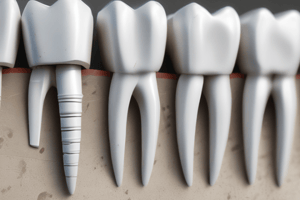Podcast
Questions and Answers
What is the maximum length that the tail should protrude through a square-cut ferrule?
What is the maximum length that the tail should protrude through a square-cut ferrule?
- One half of the rope diameter (correct)
- Two rope diameters
- One rope diameter
- One quarter of the rope diameter
When should the tail protruding from a ferrule be equal to the diameter of the rope?
When should the tail protruding from a ferrule be equal to the diameter of the rope?
- When the rope is cut with a heat process (correct)
- When the rope is not properly engaged
- When using square-cut ferrules
- When the ferrule is of tapered design
What is a critical step when using tapered ferrules according to the manufacturer's guidelines?
What is a critical step when using tapered ferrules according to the manufacturer's guidelines?
- Bending the tail end to form an eye
- Following the manufacturer's instructions for fitting (correct)
- Cutting the rope at an angle
- Ensuring the tail remains visible at all times
What formation is created when three strands of a rope are unravelled for a Flemish eye?
What formation is created when three strands of a rope are unravelled for a Flemish eye?
What should be done to ensure the strands stay together during the Flemish eye process?
What should be done to ensure the strands stay together during the Flemish eye process?
In the context of using square-cut ferrules, what happens if an annealed section is within the ferrule?
In the context of using square-cut ferrules, what happens if an annealed section is within the ferrule?
What is the purpose of the small view hole in a tapered ferrule?
What is the purpose of the small view hole in a tapered ferrule?
Which part of the rope forms the eye when creating a Flemish eye?
Which part of the rope forms the eye when creating a Flemish eye?
What factor affects the working load limit of a wire rope sling?
What factor affects the working load limit of a wire rope sling?
How does a steel core rope generally compare to a fibre core rope?
How does a steel core rope generally compare to a fibre core rope?
Why might double part legs be preferred for certain applications?
Why might double part legs be preferred for certain applications?
What is one of the factors that can affect the geometry of a sling?
What is one of the factors that can affect the geometry of a sling?
Which method of rating might be used for wire rope slings?
Which method of rating might be used for wire rope slings?
What is a disadvantage of using double part legs in wire rope slings?
What is a disadvantage of using double part legs in wire rope slings?
In terms of breaking loads, how do different constructions of rope with equal tensile strength compare?
In terms of breaking loads, how do different constructions of rope with equal tensile strength compare?
What is a key benefit of using a rope with a fibre core?
What is a key benefit of using a rope with a fibre core?
What is a key disadvantage of fibre rope slings compared to wire rope and chain slings?
What is a key disadvantage of fibre rope slings compared to wire rope and chain slings?
What is the preferred method for rating multipurpose slings?
What is the preferred method for rating multipurpose slings?
Which method is used to create eyes at the ends of fibre rope slings?
Which method is used to create eyes at the ends of fibre rope slings?
Which of the following slings present a hard point contact to the load?
Which of the following slings present a hard point contact to the load?
What is the maximum angle of inclination at which a sling may be rated?
What is the maximum angle of inclination at which a sling may be rated?
Who should assess the SWL marked on a sling?
Who should assess the SWL marked on a sling?
What is the advised practice when using multi-leg fibre rope slings with a master link?
What is the advised practice when using multi-leg fibre rope slings with a master link?
What happens to chain after the links have been welded?
What happens to chain after the links have been welded?
What characteristic of fibre rope slings has contributed to their decline in use?
What characteristic of fibre rope slings has contributed to their decline in use?
Which type of chain slings is no longer available?
Which type of chain slings is no longer available?
What defines the term 'endless fibre rope slings'?
What defines the term 'endless fibre rope slings'?
What characteristic does a heat treatment process provide to chain links?
What characteristic does a heat treatment process provide to chain links?
In terms of splicing, what influences whether the requirements differ for various types of rope?
In terms of splicing, what influences whether the requirements differ for various types of rope?
What should the SWL marked on the sling typically be?
What should the SWL marked on the sling typically be?
How do fibre rope slings compare visually with other fibre types?
How do fibre rope slings compare visually with other fibre types?
What is the consequence of using chain slings incorrectly?
What is the consequence of using chain slings incorrectly?
What is the primary purpose of using a shackle with a small jaw opening?
What is the primary purpose of using a shackle with a small jaw opening?
In what scenario are Bow shackles generally preferred over Dee shackles?
In what scenario are Bow shackles generally preferred over Dee shackles?
What type of shackle pin is commonly most suitable for various applications?
What type of shackle pin is commonly most suitable for various applications?
What problem can arise from using screw pins in applications subject to movement and vibration?
What problem can arise from using screw pins in applications subject to movement and vibration?
Which pin type is ideal when a permanent connection is necessary?
Which pin type is ideal when a permanent connection is necessary?
What is a potential drawback of using screw pins in conditions with significant movement?
What is a potential drawback of using screw pins in conditions with significant movement?
For applications that need multiple attachments to be made to the body, which shackle is most suitable?
For applications that need multiple attachments to be made to the body, which shackle is most suitable?
Which type of shackle pin provides a solution to the issue of unintended loosening?
Which type of shackle pin provides a solution to the issue of unintended loosening?
Flashcards are hidden until you start studying
Study Notes
Aluminium and Ferrules
- Under pressure, aluminium forms a homogeneous joint when used in rope formations.
- Square-cut ferrules require the rope's tail to protrude slightly, not exceeding half the rope diameter, ensuring full engagement.
- For heat-cut ropes, the protruding tail should not exceed one full diameter, avoiding annealed sections within the ferrule.
Tapered Ferrules
- Tapered ferrules keep the tail end contained, necessitating strict adherence to manufacturer fitting instructions.
- Some ferrules feature view holes to check the tail position.
Flemish Eye
- The tapered steel ferrule is slipped over the rope, with the standing part unwound to form a 'Y' shape.
- It’s crucial for the strands to remain aligned as originally laid in the rope.
Rating of Wire Rope Slings
- Working load limit (WLL) factors include rope size, tensile strength, core type, number of parts per sling leg, geometry, and rating method.
- Steel core ropes have higher breaking loads but are less flexible than fibre core ropes.
- Double leg slings offer flexibility, preferred for large capacities despite higher costs.
- Maximum rated angle for slings is 60° (120° included angle), with 45° (90° included angle) as the usual working rating.
- SWL marking should be assessed by a competent person, matching or being lesser than WLL based on conditions.
Chain Slings
- Chains are fabricated by machine processes that shape, form, and weld steel links, followed by heat treatment for desired properties.
- Wrought iron chain slings are obsolete; mild steel chains have been out of use since the early 1980s due to safety standards.
- Chain slings are robust compared to wire ropes but require proper usage to prevent damage.
Fibre Rope Slings
- Fibre rope slings, historically significant, have declined in favor of modern textile slings.
- These slings are made by hand-splicing cut lengths of rope, resulting in heavier and less pliable products.
- Available in single leg, multi-leg, or endless configurations.
- Splicing forms eyes by tucking strands back into the rope, ensuring they lock when loaded.
Identification and Shackle Use
- Different fiber types can visually appear similar; the choice of shackles affects lifting operation.
- Dee shackles are suited for joining two pieces of equipment; bow shackles accommodate multiple attachments.
- Common shackle pin types include screw pins and safety pins.
- Screw pins are versatile but can loosen under vibration; bolt-and-nut pins ensure a stable connection.
Studying That Suits You
Use AI to generate personalized quizzes and flashcards to suit your learning preferences.


